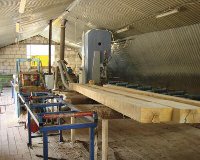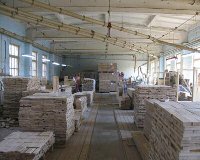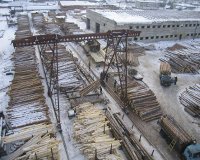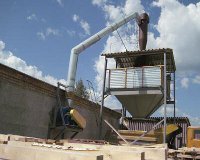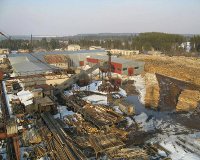Russian OSB industry about to be transformed
18 May 2012The Russian OSB industry is on the brink of big changes, due to the forthcoming commissioning of several large production facilities for OSB in the country, notably by Partner Tomsk, reports WBPI’s correspondent Eugene Gerden from Russia
There is a possibility that the largest OSB industry project is expected to be implemented in Tomsk (Russian Siberia), where a new large OSB plant will be built, by 2014, by local company Partner-Tomsk, one of Russia's largest wood processing and MDF manufacturing companies.
According to Viktoria Timoshina, cfo of Partner-Tomsk, the construction of the plant, which will have the capacity of250,000m3/year, is expected to start before the end of the first quarter of the current year, with production scheduled for the end of 2014. Total cost of the project is estimated at €150m, of which €105m will be borrowed from the banks, while the remaining €45m is expected to be allocated from the company's own resources. Currently, Partner-Tomsk is continuing negotiations with equipment suppliers and banks.
The new OSB plant is expected to be built close to another of the company's plants which specialises in the production of MDF.
The Tomsk plant will be one the first all-new Russian OSB plants to be built since 1986.
Until recently, the majority of Russian and foreign investors preferred not to take the risk and did not invest in the construction of new OSB plants in Russia, mainly due to the high costs of these projects and low demand for the products in the domestic market.
According to Svyatoslav Bychkov, head of the department of new projects of Ilim Timber Russia, (one of the world's largest producers of sawn timber), the initial volume of investment in each OSB project is estimated to be at least €100m. At the same time, there was, until recently, no rich tradition of OSB use in Russia, which could create problems for manufacturers with the sale of the production.
In addition, another problem associated with the launch of OSB production is the need for the simultaneous launch of production of special resin binders, which is an essential component in the structure of OSB production.
According to analysts of the Russian Expert business paper, the production of OSB was established for the first time in the Soviet Union in 1986 at one of the Belarus plants. However, due to technological errors and the lack of experience of OSB production, that project was suspended soon after its launch.
After the collapse of the Soviet Union and the series of economic and political crises in Russia associated with this, the production of OSB in the country was completely stopped, amid the absence of imports.
The first, small, batches of OSB were shipped from Europe to Russia in the early 1990s. In 2000 Russia imported about 2,000m3 of the panel, while by 2006 the volume of imports increased by more than seven times, mainly due to the boom in housing construction in the country.
Overall, since 2003, imports of OSB to Russia have increased by more than 15 times, despite the fact that, due to high customs duties and logistics, the cost of those imports was 1.5 times higher than in Europe.
So far, imports accounted for almost 100% of the Russian OSB market, the volume of which is currently estimated at 380,000-400,000m3/year. At present, Latvia remains the major exporter of OSB to Russia. Among the other large suppliers are Canada and Germany.
In contrast to Germany, whose share in the Russian OSB market in recent years has significantly declined, Latvia's share during the period from 2007 to 2010 has increased by almost 18 times in value terms.
Latvian company Bolderaja, part of one of the EU's largest wood based panel producers, Kronospan, currently remains the major supplier of OSB to Russia.
Still, at present, the demand for OSB in Russia remains low, due to lack of local producers and the lack of experience in the use of such materials.
Despite the fact that so far Russia still has no operating OSB plants, many potential investors have long been interested in the establishment of OSB facilities in the country.
Before the recession, more than 30 projects for the construction of OSB plants were announced for implementation in 21 regions of Russia with the participation of domestic and foreign investors, but with the beginning of the global crisis, the majority of them were postponed.
However there is a possibility that this situation may change in the near future, due to the planned, long-awaited, launch of several OSB plants in the country.
In addition to the above-mentioned Tomsk project, the first Russian OSB plant is expected to be launched by Kronospan by July of this year. The new facility is expected to be launched in Tatarstan, one of the most economically developed regions of Russia.
Later this year, another OSB plant will be established in Karelia by the local Kalevala wood processing plant. The new plant will specialise in the production of sanded, unsanded and rebated OSB. The capacity of the first stage is estimated at 250,000m3/year, while the total volume of investment in its launch is about €180m. Production is due in July of this year. The second stage of the plant is expected to be launched later and will have the capacity for another 250,000m3/year.
Despite some investors' concerns that the recent entry of Russia into the World Trade Organisation (WTO) and, associated with this, the removal of customs duties on the imports of OSB to the country will lead to the dominance of imports in the market and could make local production unprofitable, the majority of Russian experts believe that the producers will have the advantage over importers, due to access to cheap raw materials and labour.
At the same time, foreign investors, who are considering establishing OSB plants in Russia, should remember the traditional local problems associated with doing business in this country, such as administrative barriers, corruption and bureaucracy, as well as fierce opposition from some local environmental groups, who sometimes accuse foreigners of the establishment of environmentally harmful production.
In addition to the above-mentioned projects, there is a possibility that other OSB plants may be established in the European part of Russia and Eastern Siberia. Another plant could also be built in the Russian Urals.
Market prospects
Russian analysts believe that the domestic OSB market will grow significantly in the near future, which will be mainly due to ongoing growth of the Russian economy, the ever rising local demand, changing consumer preferences, as well as the implementation of numerous state programmes in the field of housing construction and, in particular, frame-panel construction, which is the main consumer of OSB in Russia.
At present Russia has substantial reserves for further growth of OSB consumption, taking into account its current low average per capita consumption, which is 66 times lower than in Canada. According to some Russian analysts, successful implementation of announced projects and further active construction of housing in the country may create conditions for the increase of the market up to 11 million cubic meters during the next seven to 10 years.
At present, more than 90% of all OSB is consumed by domestic construction, with the remaining around 8% going to furniture production and machinery packaging.
Any further increase in consumption is expected to be driven by low-rise residential housing construction (based on frame-panel technologies with the use of OSB), which is currently booming in Russia.
The global financial crisis has not resulted in a significant decline in the Russian construction industry and in particular wooden construction. The currently existing state federal programme, which is known as 'Your House', means that, of 15.7 million m2 of low-rise housing scheduled for construction in 2013-2014, more than 60% will be built with the use of wood and, in particular, OSB. This should provide an additional impetus for the development of the Russian OSB market.
At present the majority of companies which are involved in timber frame-panel construction are located in the St Petersburg region of Russia.
